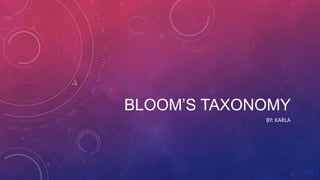Bloom’s taxonomy
•Download as PPTX, PDF•
2 likes•1,833 views
Bloom's Taxonomy by: KA
Report
Share
Report
Share

Recommended
More Related Content
What's hot
What's hot (20)
PNU CTP Ed 3 Curriculum implementation through developments

PNU CTP Ed 3 Curriculum implementation through developments
The Educational Philosophies of the World’s Greatest Philosophers

The Educational Philosophies of the World’s Greatest Philosophers
Pioneers of teaching and learning and their contributions

Pioneers of teaching and learning and their contributions
Developmental and social factors in Learning Centered Psychological Principles

Developmental and social factors in Learning Centered Psychological Principles
Similar to Bloom’s taxonomy
Similar to Bloom’s taxonomy (20)
Genesis Project: Collegiate Success through Student Development

Genesis Project: Collegiate Success through Student Development
Some Ideas about effective teaching and assessment

Some Ideas about effective teaching and assessment
Epistemology and Learning for Researchers and Teachers

Epistemology and Learning for Researchers and Teachers
Recently uploaded
Recently uploaded (20)
Benefits and Challenges of OER by Shweta Babel.pptx

Benefits and Challenges of OER by Shweta Babel.pptx
How to Manage Closest Location in Odoo 17 Inventory

How to Manage Closest Location in Odoo 17 Inventory
Spring gala 2024 photo slideshow - Celebrating School-Community Partnerships

Spring gala 2024 photo slideshow - Celebrating School-Community Partnerships
Sternal Fractures & Dislocations - EMGuidewire Radiology Reading Room

Sternal Fractures & Dislocations - EMGuidewire Radiology Reading Room
Implanted Devices - VP Shunts: EMGuidewire's Radiology Reading Room

Implanted Devices - VP Shunts: EMGuidewire's Radiology Reading Room
Removal Strategy _ FEFO _ Working with Perishable Products in Odoo 17

Removal Strategy _ FEFO _ Working with Perishable Products in Odoo 17
Đề tieng anh thpt 2024 danh cho cac ban hoc sinh

Đề tieng anh thpt 2024 danh cho cac ban hoc sinh
Features of Video Calls in the Discuss Module in Odoo 17

Features of Video Calls in the Discuss Module in Odoo 17
Bloom’s taxonomy
- 2. PEOPLE INVOLVED: BENJAMIN BLOOM • Born in 1913 • American Educational Psychologist • Bloom demonstrated that a students environment can foster the student’s potential. • Bloom developed “Bloom’s Taxonomy” which classified different learning objectives that educators can set for students.
- 3. BLOOM’S TAXONOMY Old version (1956) New version (2001)
- 4. OLD VERSION • According to the Vanderbilt University website, the old version consisted of: • •Knowledge “the recall of methods and processes, or the recall of a pattern, structure, or setting.” • •Comprehension “refers to a type of understanding or apprehension such that the individual knows what is being communicated • •Application refers to the “use of abstractions in particular and concrete situations.” • •Analysis represents the “breakdown of a communication into its constituent elements”. • •Synthesis involves the “putting together of elements and parts so as to form a whole.” • •Evaluation: “judgments about the value of material and methods for given purposes.”
- 5. NEW VERSION • Reevaluated in 2001, Psychologists renewed Bloom’s Taxonomy to match the new generation of students: • Remembering: can the student recall or remember the information? • Understanding: can the student explain ideas or concept? • Applying: can the student use the information in a new way? • Analyzing: can the student distinguish between the different parts? • Evaluating can the student justify a stand or decision? • Creating: can the student create new product or point of view?
- 6. CLASSROOM IMPLICATIONS • ◦What the teacher does under this theory? • With technology: Teachers benefit from using frameworks to organize objectives • Without: Creating learning goals in a pedagogical interchange so students understand the purpose • ◦What the students do under this theory • With technology: Students can construct, create, design, and appraise new ideas with computer and software. • Without: Students discuss, criticize, argue, or defend different ideas with one another and teachers can better understand their students.
- 7. THOUGHTS • As a future educator, I believe Bloom’s Taxonomy helps teachers understand their students needs from most important to least important. I believe this theory helps a lot of educators if used and I will use Bloom’s Taxonomy in my future classroom
- 8. CREDITS • Vanderbilt University’s Center for Teaching: • http://cft.vanderbilt.edu/guides-sub-pages/blooms-taxonomy/ • Richard C. Overbaugh and Lynn Schultz from Old Dominion University • http://ww2.odu.edu/educ/roverbau/Bloom/blooms_taxonomy.htm • Benjamin Bloom’s portrait: • Mary Forehand from The University of Georgia • http://epltt.coe.uga.edu/index.php?title=Bloom's_Taxonomy